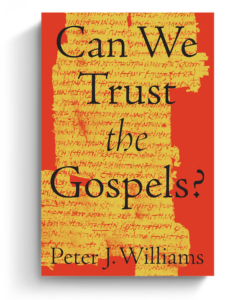Let’s say you’re reading through Exodus and you get to chapter 40, where the Levitical priesthood is being described. There you read that Aaron and his sons were to be a “perpetual priesthood throughout their generations” (Ex. 40:15). Wait, what? Perpetual? As in, never-ending—the opposite of temporary? If the Levitical priests are supposed to be perpetual, then how come we don’t have them in our churches?
This same question arises for other related issues. If the Levitical priesthood is perpetual, then one would think the tabernacle in which they worked would also be perpetual. Turns out it is:
- The lighting of the golden lampstand in the tabernacle was to be a “statute forever to be observed throughout their generations by the people of Israel” (Ex. 27:21).
- The Day of Atonement—the one day a year when the high priest went into the Most Holy Place to pour sacrificial blood on the mercy seat—was to be a “statute forever” (Lev. 16:34).
- Long before that, God had told Abraham that the covenant of circumcision in his flesh was to be an “everlasting covenant” “throughout your generations” (cf. Gen. 17:11, 12).
Bible-believing Christians are perfectly comfortable living our lives and leading our churches with no Levitical priests, no golden lampstands, no Day of Atonement, and no circumcision. Why? Is it because we don’t take these passages seriously? Have we somehow embraced a “Greek” Christianity that’s shorn of its Jewish roots?
The answer is no. But the question is worth exploring because this is a test case for how to interpret the Bible. To be more precise, it’s a case study in how to interpret the Bible with a redemptive-historical lens, allowing the New Testament to guide our interpretation of the Old Testament.
Later Revelation Interprets Earlier Revelation
Historically, many Christians have referred to Old Testament practices like circumcision and priestly rules as “ceremonial” or “positive laws” (as distinguished from moral laws) and have argued they’re no longer binding in the New Testament. Whether you like that terminology or not, it’s a good-faith attempt to listen to all of Scripture to understand why some laws were discontinued while others weren’t.
For example, the reason Christians don’t regard circumcision as a perpetually binding practice (despite Gen. 17:13) isn’t because of a natural aversion to being cut. Rather, it’s because of straightforward New Testament passages like 1 Corinthians 7:18–19:
Was anyone at the time of his call uncircumcised? Let him not seek circumcision. For neither circumcision counts for anything nor uncircumcision, but keeping the commandments of God. (cf. Gal. 5:6; 6:15; Col. 3:11)
Paul takes something the Torah commanded on pain of death (Ex. 4:24–26) and basically says, “It doesn’t matter.” Unless you’re going to accuse Paul of being a false prophet who rejected the Old Testament, you have to wrestle with why he said this. What categories was he employing to arrive at such a jarring conclusion? At the very least, this should give you a starting point for why Christians don’t get their circumcision ethics straight out of Genesis 17.
This a case study in how to interpret the Bible with a redemptive-historical lens, allowing the New Testament to guide our interpretation of the Old.
This principle also explains why we can’t simply go straight to the “perpetual” texts cited above and conclude, “We’ve got to obey them literally, or else we’re refusing to believe the Bible.” Later revelation must be allowed to explain earlier revelation. You can’t interpret phrases like “perpetual priesthood” and “statute forever” apart from the New Testament. The New Testament gives us an inspired interpretation of how those Old Testament ceremonies were fulfilled.
Shadows Point to the Substance
But lest this sound arbitrary—as though we were simply comparing the dates and concluding that later must be better, let’s pay attention to how the apostles reached their conclusions. Their purpose was never to critique or dismiss Old Testament ceremonies in themselves but rather to show how they were intended to point to Christ all along.
In Colossians 2:17, for example, Paul uses the language of “shadow” and “substance” to describe the relationship between Old Testament ceremonies and Christ. A shadow is cast by a substance (e.g., a body). Questions of food and drink, festivals, new moons, Sabbaths—all these were shadows cast by the approaching Christ. But Christ is the substance, and when he arrives, we aren’t to allow others to pass judgment on us in such shadowy matters.
The writer of Hebrews uses this same language to describe the relationship between the Levitical priesthood with its tabernacle context and Christ the great high priest. These earthy priests, he says “serve a copy and shadow of the heavenly things” (Heb. 8:5). Moreover, Hebrews 9 is clear that these outward types were only meant to endure “until the time of reformation” (v. 10).
So regarding the Day of Atonement, Hebrews 9 teaches that Christ fulfilled it when he entered once for all into the true holy place in heaven (vv. 11–28). This means that when Leviticus 16 calls the Day of Atonement a “statute forever,” we have to include the fulfillment in that word “forever.” What the Day of Atonement was pointing to will endure forever. But that doesn’t mean the ceremony itself would endure forever.
Once More on the Levitical Priesthood
The book of Hebrews relates Christ to the Levitical priesthood in two different ways. It not only teaches that Christ fulfilled the Levitical priesthood when he went into the true holy place in heaven to offer himself but also teaches that Christ belongs to a better priesthood than that of Aaron. Once again, the order of events in redemptive history plays a key role here.
The writer points out that before the law was ever given, Moses spoke of another priest named Melchizedek (see Gen. 14:18). Then after the law was given, Psalm 110 tells us another priest was going to arise after the order of Melchizedek. So putting all those things together—Genesis 14, which was before the law, and Psalm 110, which came after the law, the author of Hebrews reasons like this:
If perfection had been attainable through the Levitical priesthood (for under it the people received the law), what further need would there have been for another priest to arise after the order of Melchizedek, rather than one named after the order of Aaron? For when there is a change in the priesthood, there is necessarily a change in the law as well. (Heb. 7:11–12)
For Psalm 110 to come true, the law would have to change. In other words, the Old Testament was already indicating Aaron’s priesthood wasn’t going to last forever in the literal sense. It was bound up with the old covenant—but when the new covenant came, the old covenant would vanish away, along with its priesthood (Heb. 8:13). It would then be superseded by a better priest—a priest who’d never have to be replaced because he’d live forever.
The Old Testament was already indicating Aaron’s priesthood wasn’t going to last forever in the literal sense.
In short, the writer of Hebrews isn’t saying, “Aaron’s priesthood wasn’t perpetual after all—Exodus 40 just got it wrong.” Nor is he saying, “You would never have gotten any this from the Old Testament, but since I’m an inspired apostle, I can fill in the gaps for you.” Instead, he’s saying, “This is already there in the Old Testament. You just need to know how to put the pieces together properly.”
So when we read about “perpetual priesthoods” and “forever statutes,” we mustn’t read these promises as though Exodus were all the Scripture we had. We must heed Paul’s counsel and “remember Jesus Christ” (2 Tim. 2:8). The One in whom “all the promises of God find their Yes” (2 Cor. 1:20). The only son of Israel who is truly “a priest forever.”
Is there enough evidence for us to believe the Gospels?
 In an age of faith deconstruction and skepticism about the Bible’s authority, it’s common to hear claims that the Gospels are unreliable propaganda. And if the Gospels are shown to be historically unreliable, the whole foundation of Christianity begins to crumble.
In an age of faith deconstruction and skepticism about the Bible’s authority, it’s common to hear claims that the Gospels are unreliable propaganda. And if the Gospels are shown to be historically unreliable, the whole foundation of Christianity begins to crumble.




































